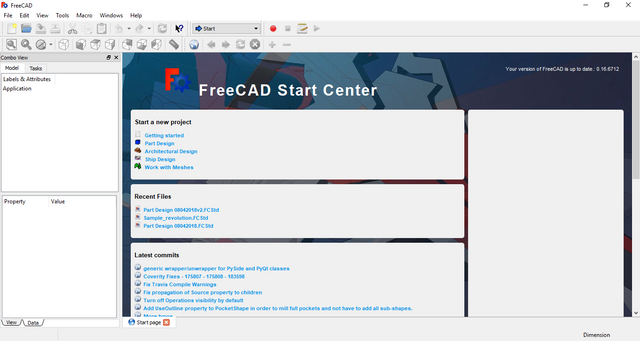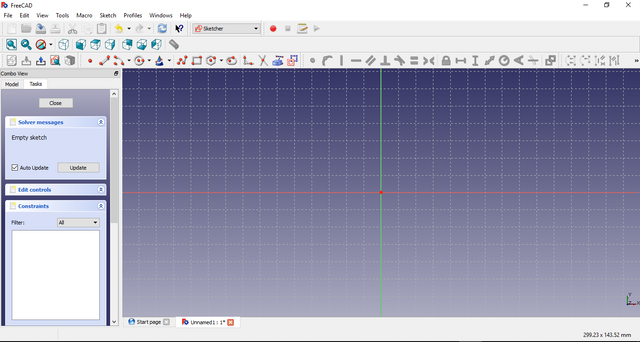Promoting the Free and Open Source Software for 3D CAD Modeling - FreeCAD and Its Sketcher Workbench
Repository
https://github.com/FreeCAD/FreeCAD
Introduction

This is a promotional post about my experience using FreeCAD, its differences with other proprietary softwares I’ve used previously such as Autodesk Inventor and Siemens NX; and its similarities with CATIA.
How Did I Know FreeCAD?
Before I proceed in promoting this parameterized 3D modeler, allow me to share on how did I came to know this CAD software. It was when I became a contributor to @utopian-io’s “Translation” category that I discovered FreeCAD and as far as I remember it was in the late part of January or early part of February wherein at that time all contributions to that category is done with the usage of Crowdin platform. At first I didn’t give much attention to that project since it has been translated and almost complete though it hasn’t been given attention for further proofreading. And last April, I gave it a try to download this software with the intention of learning Stack-up Analysisat home during weekends since I didn’t have much time doing it inside the office that I am working as a mechanical design engineer due to the fact that most of my workloads are into creating or modifying 3D models, creating manufacturing drawings by parts, assembly drawings and a little bit of checking PCB schematic diagrams to make the assembly drawing complete starting from the smallest electronic components (blades) up to the largest components which are plastic (fuses or relays) or metal (busbar) parts. Upon installing this software, I was so excited to use it and though my gut feeling says that this software would be a bit of struggle for me since the UI is much similar to CATIA and I have to admit that I am having an advance skills when it comes to using Siemens NX software which is a result of having projects requiring the usage of that software and whereas for CATIA, I am only having basic knowledge which is a result of the training provided by the company I’ve previously worked on. Going back to my intention of learning "Stack-up Analysis" using FreeCAD software, I have to start using the features of the software from the very beginning which is in layman's term, I need to learn from creating a sketch, then creating a 3D model and eventually, creating a drawing of the model I've created for which the drawings would serve as my guide in presenting the tolerance stack analysis.
What is FreeCAD?

FreeCAD is a free and open source software (FOSS) built purposely for the creation of 3D parameterized models and is designed for CAD designers, design engineers, architects and developers especially those proficient in Python programming. This software has a similarity to CATIA which is a proprietary CAD software built by Dassault Systèmes. The very reason why I considered these two softwares to be related is because they have these so-called “Workbench” for which a designer/engineer can use depending on the nature of the task. As for workbenches found between the two softwares these includes the following: “Sketcher Workbench”, “Part Design Workbench”, “Drawing Workbench”, just to name a few. Additionally, as a completely free to use software, I highly appreciate and commend the developers for adding features such as Finite Element Analysis (FEA) for which I only have an overview lesson on this important part of engineering design since these tasks where given to another department of the company I’ve previously worked on.
What Makes FreeCAD Different from Other Proprietary Softwares?
When we talk about the differences of FreeCAD from those proprietary softwares we simply mean about its features and as for this blog, we will only tackle the "Sketcher Workbench".
When creating parts through CAD softwares, the very first thing to do is to create a sketch and when we use FreeCAD, we will be using "Sketcher Workbench".

The Sketcher Workbench of FreeCAD employs the so-called “Constraint Sketching” for which a sketch must be completely constrained by means of controlling or locking the degree of freedoms or in layman’s term, the sketch must be locked in both x and y axes and at the same time be applied with a geometric constraint or dimensional constraint such as radius of a curve or an arc or perhaps the length of a vertical or a horizontal line. I have to admit when I got introduce to the concept of constraints, I thought the facilitator of my CATIA training is talking about “Assembly design” since when I was a student, I only heard of constraints when we use the Assembly feature of Autodesk Inventor for mating parts are joined together by the utilization of numerous constraints. Additionally, this type of sketching is used in CATIA’s Sketcher Workbench. As for other software such as Autodesk Inventor and Siemens NX, they employ traditional sketching wherein anyone can simply create sketches be it a simple rectangle, polygon or perhaps a much complicated sketch which is composed of lots of arcs of different radii. I’d say, “Constraint Sketching” is a tedious task especially when dealing with complex sketches that is composed mainly of curves or arcs of varying radii, since you need to apply constraints for each curve and pretty sure would give headache especially to those people having no background in CAD software.
Well, in the videos that I created below, you can see how it is like to do a sketch using FreeCAD’s Sketcher Workbench and let’s be honest, it’s pretty tedious and somewhat dirty when working on a sketch that has plenty of curves be it a line or an arc since numerous constraints are being involved starting from geometric constrains up to datum constraints. But don’t worry about having a bit dirty sketch, it only applies on this workbench and you’ll appreciate its beauty since the sketch is locked which means no unnecessary movements such as those resulting from movements of your mouse (which has the potential to change the appearance of the sketch, for example the concavity of the curve) can modify the sketch’s appearance and when there is a need for modification on the sketch, the user only need to pick that constraint and change it accordingly. And as for other software, modification of sketch would often result to re-creation of sketches depending on the nature of the modification that need to be done. Additionally, since we are all unique and have its own predefined preferences, I’d say the methods in achieving a sketch that is fully-constrained are many and comes in various forms. (Note: In these two videos, the version I’m using for FreeCAD is v0.16.6712.)
For the first video, the sketch is based on what is found in the FreeCAD Sketcher Workbench Tutorial.
For the second video, the sketch was downloaded randomly from the web.
Before this blog ends, I’d like to inform the potential users of this software especially those having no prior background in “Constraint Sketching” and even 3D CAD softwares such as CATIA, to please read the documentation and the tutorials found in the official website of FreeCAD so that you’ll have a pretty straightforward learning progress. And lastly, for people having prior experience in 3D CAD software such as Siemens NX and Autodesk Inventor, at first you'll get upset on why you need to use constraints, well, take heart it's just the beginning and later on, you'll appreciate the beauty that constraints sketching is offering.
Resources
Series Backlinks
This is my first blog promoting FreeCAD and in my next blog, I’ll talk about the “Part Design Workbench”, and later on, the "Drawing Workbench". Creating an assembly of models/parts should have followed "Part Design Workbench" but unfortunately, it is still under heavy development by the community of FreeCAD.
This was an interesting post, promoting a major open source project. It is clear that you used the application and have insight and experience to share.
That said, the post could have used further attention when it comes to style and grammar. Many sentences are needlessly complex, which makes them difficult to read. I'm going to cite some examples of places where it could have improved.
"Upon installing this software, I was so excited to use it. However, I had a gut feeling that this software would be a bit of struggle for me since the UI is so similar to CATIA. I have to admit that while I have advanced skills when it comes to using Siemens NX software - a result of having projects requiring the usage of that software - I only have basic knowledge using CATIA, in which I had training provided by the company I’ve previously worked on."
In the future, please consider using a service such as Hemingway to go over the post before publications. I think it could really help you elevate your posts. Thank you for your contribution.
Your contribution has been evaluated according to Utopian policies and guidelines, as well as a predefined set of questions pertaining to the category.
To view those questions and the relevant answers related to your post, click here.
Need help? Write a ticket on https://support.utopian.io/.
Chat with us on Discord.
[utopian-moderator]
Thank you for the insights @didic! I would apply it in my next contributions. :)
Thank you for your review, @didic!
So far this week you've reviewed 10 contributions. Keep up the good work!
Changed to the blog category.
Need help? Write a ticket on https://support.utopian.io/.
Chat with us on Discord.
[utopian-moderator]
Hey @josephace135
Thanks for contributing on Utopian.
We’re already looking forward to your next contribution!
Want to chat? Join us on Discord https://discord.gg/h52nFrV.
Vote for Utopian Witness!
Any free tutorial for this....
Hi @josephace135! We are @steem-ua, a new Steem dApp, computing UserAuthority for all accounts on Steem. We are currently in test modus upvoting quality Utopian-io contributions! Nice work!
Congratulations! Your post has been selected as a daily Steemit truffle! It is listed on rank 20 of all contributions awarded today. You can find the TOP DAILY TRUFFLE PICKS HERE.
I upvoted your contribution because to my mind your post is at least 6 SBD worth and should receive 111 votes. It's now up to the lovely Steemit community to make this come true.
I am
TrufflePig, an Artificial Intelligence Bot that helps minnows and content curators using Machine Learning. If you are curious how I select content, you can find an explanation here!Have a nice day and sincerely yours,

TrufflePig